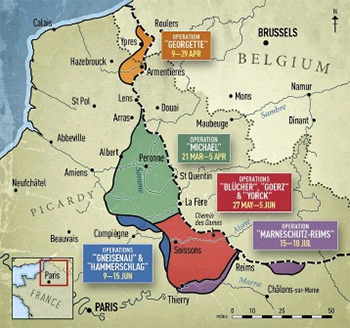The 1918 German Spring Offensives
The German Spring Offensives were collectively the last serious advance of any of the Central Powers during World War I. Allied armies eventually turned back the initial gains made by the German thrusts. German forces had ordered a somewhat orderly retreat behind the Hindenburg Line, a series of defensive fortifications set up in 1917. The major battle in the West during that year was the struggle for control of Passchendaele, which the Allied forces eventually did win, albeit after suffering large numbers of casualties. The United States's declaration of war on Germany in 1917 prompted the German command to made one last attempt to end the war on their terms. The Russian Revolution had resulted in Russia's ending their role in the fighting, via the Treaty of Brest-Litovsk, in early March 1918. Starting not long after that, Germany launched four major offensives, designed to break through Allied lines, outflank the members of the British Expeditionary Force, and finally convince the French to give up, after suffering even more high numbers of dead, injured, and captured. 
The four offensives were named Michael, Georgette, Blücher-Yorck, and Gneisenau. The first began on March 21, with the largest bombardment of the entire war. German guns fired 1.1 million shells against Allied positions in just five hours. The German attack that followed occurred under a general fog and was highly successful, driving the BEF forces into full retreat. The German advance occurred along a wide line; some parts of the advance were more successful than others at breaking through. In fact, the attackers that advanced the farthest ran ahead of their supply lines' capability and were on their own for a time. Operation Michael ended on April 5, with the German Army having advanced the furthest it had done since the start of the war. Allied forces were still in possession of Amiens and other vital places. Losses on both sides were more or less equal: about 250,000. Not resting long, the German high command ordered Operation Georgette to begin on April 9. Again finding success, German forces moved on. Again, they had to fall back, for lack of support, this time on their flanks. The operation ended three weeks after it had begun, with losses on both sides exceeding 100,000. Operation Bluücher-Yorck commenced on May 27, targeting depleted BEF forces, and was largely successful. German troops advanced to the Marne River, within long range guns' shooting distance of Paris. The operation ended on June 6, with both sides losing about 130,000 men. Operation Gneisenau began on June 9 and advanced along the Matz River. A sudden French counterattack stalled the German advance three days later. Losses were 35,000 Allied and 30,000 German. The end result of all of these operations was a much improved position for the German Army relative to where the front line had been for the past three years. However, the position was unholdable, especially since the new Allies the United States were pouring troops into France in order to shore up Allied defenses. |
|
Social Studies for Kids
copyright 2002–2026
David White




